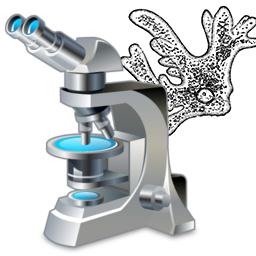Ameba Lab - Watch it Move!
Amoebas are single-celled organisms belonging to the phylum Protozoa, known for their distinct way of moving and feeding. They typically live in freshwater environments, although some species can thrive in soil or marine habitats. Amoebas are classified under the genus Amoeba, and various species exist with slight differences in their characteristics.
-
Shape and Structure: Amoebas lack a fixed shape and have a characteristic blob-like appearance. They are composed of a flexible cell membrane that surrounds the cytoplasm. The cytoplasm contains various organelles like the nucleus, food vacuoles, and contractile vacuoles.
-
Locomotion: One of the most notable traits of amoebas is their mode of movement known as "amoeboid movement." They achieve this by extending their cytoplasm in the form of temporary projections called pseudopodia (singular: pseudopodium). The pseudopodia help them crawl, engulf food particles, and change their shape.
-
Feeding: Amoebas are heterotrophic organisms, meaning they obtain their nutrients by engulfing food particles. They feed by extending pseudopodia around their prey, forming a temporary food vacuole. Inside the vacuole, enzymes break down the engulfed food into simpler molecules that the amoeba can use for energy.
-
Reproduction: Amoebas primarily reproduce asexually through a process called binary fission. In binary fission, the amoeba's nucleus divides, followed by the cell dividing into two daughter cells. Some species also engage in sexual reproduction or form cysts to survive harsh conditions.
-
Habitat and Adaptability: They are found in diverse aquatic environments and can adapt to varying conditions. Some amoebas are also capable of surviving in temporary water sources by forming cysts during unfavorable conditions, allowing them to remain dormant until conditions improve.
-
Role in Ecosystem: Amoebas play a role in the ecosystem as decomposers, breaking down organic matter and recycling nutrients. They are also part of the food chain, being consumed by larger organisms.
Laboratory Investigation
In this lab you will view the movement of a single celled organism called the ameba. The full scientific name of the organisms is Ameba proteus, and it is a protist that moves by using cytoplasmic extensions to create "false feet" - PSEUDOPODIA.
Obtain a slide of a live ameba. You will need to be patient in finding your ameba on the slide; it will look like a gray blob.
When you think you have found the ameba, focus on the blob, if the blob does not move or change shape within a minute, it is probably NOT an ameba.
1. When you have finally found your ameba, you are going to record its movements over a 20-minute period. At about 2-minute intervals sketch the ameba as it appears in your microscope under low power.

2. In one of the pictures above, label the NUCLEUS, CELL MEMBRANE, and PSEUDOPODIA.
Ameba
Live Amoeba can be purchased from Amazon (sponsored)
 Download as a Google Doc
Download as a Google Doc 